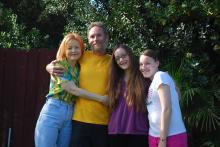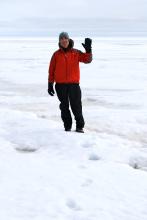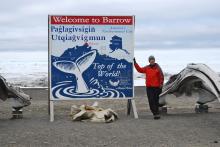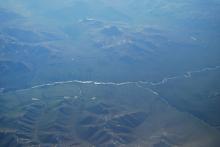What Are They Doing?
The carbon cycle is the means by which carbon is moved between the world’s soils, oceans, atmosphere, and living organisms. Northern tundra ecosystems play a key role in the carbon cycle because the cold, moist, and frozen soils trap rotting organic material in the soils. This very slowly decaying organic material has caused carbon to build up in the arctic during the past thousands of years. Now warming in the arctic is slowly causing the tundra to become warmer and dryer. As a result, the trapped carbon leaves the soil as carbon dioxide and goes into the atmosphere.
The research team studied changes to the carbon cycle in northern forests by setting up experiments that copy the setting of warmer and dryer tundra. When they arrived at the field site they first removed snow from the research sites, constructed new warming chambers, installed water wells, and set up a carbon dioxide measuring system. After the set-up, the team began taking field measurements of carbon dioxide exchange between the soil and atmosphere, permafrost thaw depth, and water table depth. In addition, they took samples of plant and soil and studied the plant life cycles, also known as phenology.
The experiment is part of the Carbon in Permafrost Experimental Heating Research (CiPEHR) project. The results of their research will be helpful in predicting how the warming and drying tundra will affect the carbon balance, and how the release of additional carbon dioxide will affect global climate change.
Where Are They?
The research team was based at a remote cabin near the small town of Healy, Alaska, about 100 miles south of Fairbanks, Alaska. They traveled via four-wheel drive roads to various sample sites in the boreal forest and foothills of the Alaska Range. The research sites are within the framework of the Carbon in Permafrost Experimental Heating Research (CiPEHR), an ecosystem warming experiment located in Alaska’s discontinuous permafrost zone.
Latest Journals
Sue Natali is an assistant scientist at Wood Hole Research Center (WHRC). Her research focuses on the interactions and feedbacks between plant and soil communities and their environment and seeks to better understand the impacts of environmental change on ecological processes and biogeochemical cycles. Dr. Natali conducts her research in boreal and tundra ecosystems in Alaska and Siberia. Learn more about Dr. Natali and her work at the WHRC webpage.

Ted Schuur is an Associate Professor of Ecosystem Ecology within the Department of Botany and Zoology at the University of Florida. His research focuses on the interaction between carbon cycling in terrestrial ecosystems and climate change. Dr. Schuur is particularly interested in the exchange of carbon between plants, soils, and the atmosphere, and the response to changes in climate and disturbance regimes.





